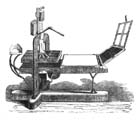A Yacht for THE R——T'S B—M—.
Transcription of header material:
The Yacht for THE R——T'S B—M—. A Poetical Epistle, from Brother John in England, to Brother Pat in Ireland.
Description:
This work, like Hone’s View of the Regent’s Bomb, is a half-sheet broadside. The sheet is divided roughly into thirds, with a hand-colored yellow engraving of the ship at the top; a poem (the “Poetical Epistle” of the title) in three columns in the center; and a prose description of the yacht in two columns at bottom. Across the bottom of the page is the citation: "The Engraving above is by Mr. James March, from a correct view of the Yacht taken by him, expressly for this Publication, on Monday, the 26th of August, 1816, off Deptford Dock Yard." (Bowden identifies “James March” as a George Cruikshank psuedonym; see Bowden, I, 95, n. 134.) Beginning in late August or early September, Hone sold the broadside for 6d from his shop at 55 Fleet Street.
Contents:
The poem is a cynical description of the pomp and expense that go into a yacht that was at that time being fitted for the use of the Prince Regent. As Hone saw it, the ship was extremely extravagant with plenty of gilt and mahogany. The speaking character, “Brother John,” an ordinary Englishman, describes the economics thus:
(All this at a time
When the national Crime,
Is poverty—poor Johnny Bull!—
And the taxes, long faces,
And sinecure places,
Fill his cup of affliction full!)
The prose section of the work begins its description of the Regent’s yacht with the apparently admiring sentence:
“This superb Yacht, the Royal Sovereign, was launched from Deptford Yard on Thursday, the 8th of August, 1816, having been newly copper-bottomed and entirely new gilt and fitted up throughout. –She . . . is the most splended vessel, beyond all comparison, ever launched in England.”
But the admiration quickly dissolves into dismay over the Regent’s extravagance:
"The vessel has been put into its present state, for the Prince Regent, at an estimated expence of upwards of SIXTY THOUSAND POUNDS: the gilding alone is supposed to have cost near Thirteen Thousand Five Hundred Pounds! . . . And it is remarkable that the Cardinal virtues are amongst the most prominent decorations outside!”
Note:
The British Library volume containing Hone's 1816 publications regarding the Regent’s "bomb" also has a number of undated publications of Fairburn by "Peter Pindar"—satirical verse about the numerous follies of the Prince Regent, Castlereagh, &c. This bibliographical fact indicates something of the genre of Hone’s contributions.
